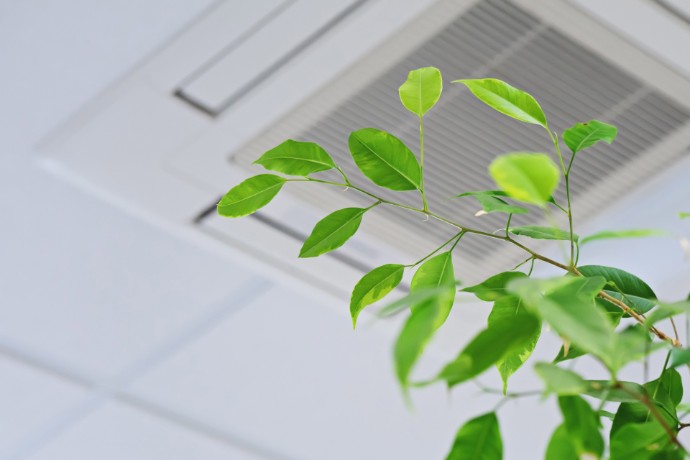Does Air Conditioner Kill Plants

Indoor gardens are lovely! It’s a trendy thing to have an indoor garden even when you’re living in apartments nowadays. So, it does raise a concern if the air conditioner affects our lovely plants. So, does air conditioner kill plants?
Yes, air conditioners can kill plants if nothing is done to regulate the environment for ideal plant growth. Plants thrive on ideal conditions of light, heat and humidity. Air conditioners affect heat and humidity by lowering temperature and removing moisture. You should make a few changes and support your plants a little more.
How to create optimal growing conditions for indoor plants?
Get Houseplants Far from Air Vents

A chilly climate is intense enough on foliage, yet straightforwardly blowing cold air from AC vents aggravates it. The moving air is getting dried out, stripping plants of much-required dampness. Furthermore, the impacts of cold air can cause freezing in the plant cells, so supplements and water can presently don’t move unreservedly inside the plant. Have you seen yellowing leaves, or withering of your houseplants, particularly in case they’re close to vents? Those are signs the plant is starving because of impeded cells and cold-harm.
The principal line of guard is to move plants from all vents (or considerably another, hotter, room), yet that can represent an issue for plants requiring bunches of daylight. To best cool a home, cooling ventilation work runs along outside dividers with vents frequently before windows. So if your plants need regular light, put resources into a safeguard or diverter to coordinate the wind current away from the plant life while as yet utilizing it to cool your home.
Avoid the Plants From Direct Contact With Streams of Air
Window ACs are regularly intended to blow the air straightforwardly forward. Plants can freeze in the event that they come into direct contact with the virus air, and it will keep them from getting water and supplements as their pathways are hindered.
In case space is tight at home and you can’t move your plants to another area, you can work with AC administrations to decide the best AC for your home.
In the event that you place your best plants around an AC unit, they won’t just freeze yet will likewise lose their dampness. Assuming you need to try not to have your home plants pass on, you should try not to put them close to your AC.
For homes that utilization ventilation frameworks for cooling, get your plants far from any vents. This will keep them from getting smacked from the chill or warm air for the duration of the day.
It’s simple but an essential way to avoid air conditioner from killing your plants.
Reestablish Lost Moisture

A few plants do fine in dryer conditions, yet others are more delicate to the decreased dampness cooling makes. Lower dampness makes your home more open to, causing it to feel cooler. Higher moistness can feel choking, and can prompt form and mold development whenever left unchecked. Yet, your plants actually need dampness, particularly in case it’s being taken from the encompassing air.
Plants (particularly with flimsy leaves) may wither and blossom buds might tumble off if a plant is drying out. Keep the plant’s dirt appropriately watered, however for your more fragile plants, every day moistening will assist them with flourishing. Be careful with overwatering, however which can hurt the plant and lead to shape creating. On the off chance that indications of overwatering show up (enlarged leaves or stained water spots), fog plants less regularly.
Water them as needed to avoid the air conditioner from killing your plants.
Make Mini Greenhouses (Terrariums)

For the most delicate of plants, glass vaults or terrariums will shield them from losing hotness and dampness, while as yet permitting you to appreciate them in your really living spaces. Terrariums are best for more modest plants—the following are a couple of good decisions. Then, at that point, you can begin with a storebought terrarium, similar to this one from Target, or take a more DIY course.
It is feasible to have a cooled indoor environment that is agreeable for yourself as well as your houseplants. With some arranging and care, you can partake in awesome of both.
5 best indoor plants that can survive air conditioners
Cooled rooms have a cool temperature, cold drafts, and dry air, which hurts the development of your indoor plants. Also, not all indoor plants can get by in such living molded.
Yet, this was the sort of thing I sort out the most difficult way possible. I killed over twelve plants before I discovered that not all plants would do great in an aircon space.
Hence, I chose to set up a list of plants that can survive in a cooled space for your reference. Without further ado, let’s get rolling.
1. Snake plant

The snake plant is a famous and least demanding houseplant to develop and keep up with. They are pardoning, dry season open minded, and can live in an assortment of conditions.
Snake plants are solid plants and phenomenal for your cooled rooms. They will upgrade the magnificence of the space and clean air as a little something extra and make the air breathable.
Daylight: Snake plant prefers splendid sifted light for 6-8 hours yet can get by in low light and obscure corners. They can likewise flourish in circuitous light. You can likewise utilize counterfeit light sources to give them adequate light.
Watering: Water your snake plant just when the dirt is completely dry. They don’t care for their dirt to sit in water. You can check the dirt by burrowing a finger or stick several creeps in the dirt. On the off chance that the dirt feels sodden or the dirt adheres to the stick, then, at that point, sit tight for watering.
Manure: Fertilize snake plant once consistently in the developing time frame with a reasonable houseplant food. Weaken the manure to a large portion of the strength and try not to take care of the colder time of year and fall.
General Care: Keep your snake plant in a warm spot, at a temperature level above 50°F. During cooler months, get them far from cold drafts.
2. Pothos

Pothos are tropical plants that arrive in a course of action of shadings and examples that beauty the stylistic layout and tastes.
They develop decently lenient and adaptable houseplants with glossy heart-formed leaves. Pothos even clean poisons from the air and can be kept in practically all conditions, even in cooled rooms.
Daylight: Pothos like roundabout, separated light and can endure low to direct light as well. They can’t endure direct light as it can consume their leaves.
Watering: Water the pothos once per week in a perfect world, permit their dirt to dry between watering. Ensure the overabundance water channels out subsequent to watering. Dial back the recurrence of watering in the torpid period.
Manure: Pothos are light feeders, so apply a fair compost each 2-3 months to keep them sound. Prepare 25% of the suggested dose and try not to take care of in the torpid period.
General Care: Keep the temperature above 50°F around your pothos. They lean toward high mugginess, and periodic moistening can help.
3. ZZ plant

ZZ plant is a low-support plant with lustrous, oval-molded dark green foliage and will make an exceptional expansion to your room. They are dry season patient and meek to a wide scope of conditions.
Most unpracticed landscapers can likewise grow a solid ZZ plant. They can flourish in a climate control system room set between 70°F-85°F.
Daylight: ZZ plant enjoys splendid circuitous light, regardless of whether regular or counterfeit. The leaves can consume in an excessive amount of direct light. Notwithstanding, they can endure all lighting.
Watering: Water the ZZ plant one time per month. They are dry season lenient. Allow the dirt totally to dry out among watering, and the dirt ought not be kept saturated.
Manure: ZZ plants are light feeders and even can flourish without taking care of as well. Prepare with a reasonable houseplant food by weakening it to a large portion of the strength. Try not to prepare them in the lethargic period.
General Care: ZZ plants are content with family dampness and temperature. Kindly don’t keep them in temperature levels beneath 45°F and stay away from cold drafts.
4. Spider plant

Spider plant is versatile, low upkeep, agreeable plant with bending green or green and white striped surrenders that can develop to 1.5 feet long.
They have a moderate development rate. They are excusing plants and can flourish even in AC-treated homes.
Daylight: Spider plants like to fill in light shade, and brilliant light will keep them becoming sound. Direct sun can consume their leaves, and low light can make their development and wellbeing slow.
Watering: Keep insect plant’s dirt somewhat damp and not dousing. They can be watered one time each week however really taking a look at the dirt clamminess prior to watering will save them from water issues. Water them with sifted or water.
Compost: Moderate measures of food will keep your bug plant glad. A reasonable houseplant food that is weakened ought to be taken care of to them in the developing season once consistently.
General Care: Spider plants like warm and damp conditions. They ought to avoid cold and hot drafts. Temperature underneath 50°F can hurt them and even hinder their development.
5. Monstera

Monsteras are otherwise called swiss cheddar plants because of openings in their leaf. They are nice, adaptable plants with lovely foliage.
These are vining plants and trail over or alongside the sticks. They are versatile, which settles on them perhaps the most ideal decision to keep in a cooled room. They simply need minimal consideration to flourish.
Daylight: Give your monsteras some brilliant roundabout light or even low light. They can even require a few hours of direct light, yet an excess of direct light can cause mischief and consume the leaves.
Watering: Water monsteras once per week in summer, keep the dirt dry and not wet. Overwatering can hinder their development or kill them. Water them less in the cooler months to keep away from root decay.
Manure: Fertilize monsteras with a fair houseplant food by weakening the solidarity to a large portion of the suggested dose. Taking care of them once per month in the developing time frame is sufficient.
General Care: Keep the dampness level high around your beasts, and incidental clouding can assist them with remaining hydrated.
Temperature level between 50°F-80°F is great for monsteras. Be that as it may, get them far from cold drafts and direct air from the warming frameworks.
Protect Your Indoor House Plants
So, does air conditioner kill plants? While your home can be sweltering throughout the mid year, you need to recall that your plants will struggle making it if you don’t play it safe.
The greater part of the normal indoor plants can endure and coincide with air conditioner systems if that you don’t expose the plants to them. Thinking of how frequently you change the temperature and think about your choices.
We’ve listed 5 basic indoor plants that can survive even the harshest conditions. Think there’s more? Share them in the comments below!
Facing any problems with your air conditioners? Let us figure out what is wrong and fix your AC for you! Reach out to us at Sol Aircond Service today!




0 Comments